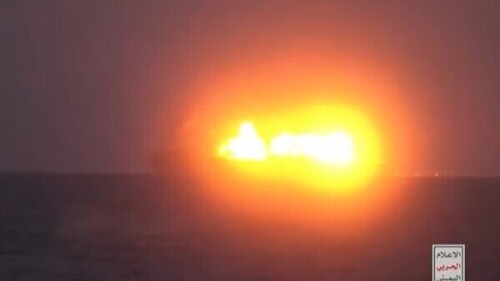The crew of the Gulf Sky were stuck on board the oil tanker for more than six months before the July 6 hijacking. |
The crew of the Gulf Sky are mostly safe today. Twenty-six of them arrived back in India on July 14. Two are now in Iran, having been stuck on board the oil tanker for more than six months, much of it spent at anchor off the United Arab Emirates. With the tanker at the center of a court case in the US against the Iranian Islamic Revolutionary Guard Corps and the ownership of the Dominica-flagged vessel disputed, the tanker wasn’t supposed to go anywhere.
However, the crew say they were hijacked and taken to Iran.
How did it happen? This is the third part of a Jerusalem Post investigation into the disappearance of this tanker, after the website Tanker Trackers revealed that it had turned its transponder off and satellite photos showed it mysteriously turn up near Iran’s Hormuz island on July 7.
The crew say they were hijacked and taken to Iran.
Now, according to the website and magazine Safety At Sea, the crew say they were held at gunpoint and taken from their UAE anchorage on July 6. We previously documented that a UAE-flagged supply ship met the Gulf Sky for 58 minutes on July 5. The crew has spoken anonymously to Safety at Sea.
This account provides new details. The Commonwealth of Dominica Maritime Administration only told the US that the tanker was missing on July 13, a week after it had disappeared. Now the crew say that “heavily armed” men boarded the ship and took them away from UAE waters.
It is highly unusual for pirates or hijackers to do this off the coast of the Emirates, one of the world’s most heavily trafficked waterways for oil tankers. There are a plethora of security assets from American, French, UK and other navies in this area, including major naval ships, as well as drones that monitor the area for Iranian weapons trafficking to Yemen.
In short, the fact that armed men supposedly boarded a large Suezmax-size million-barrel tanker and took it away has major ramifications for maritime security. But if the story is exaggerated, then it leads to questions about who piloted the ship to Iran.
The armed men came aboard the ship disguised as “surveyors.” The crew say they were made aware of a coming inspection on July 2. They were told to prepare the engines, which raised suspicion. The crew was gathered in a room usually used for meals and kept there. Some were tied up and they claimed they were shouted at and even tortured. The ship left its anchorage just after midnight on July 6 and arrived in Iranian waters by July 7.
The crew were kept hostage on the vessel until July 14 when the hijackers surprisingly disembarked them after a new sailing trip of 14 hours. From there, the men took a bus to an airport and found 26 tickets to India waiting for them. Someone had used their passports to secure them tickets. The two crew members who were left behind had expired documents.
The incident is supposedly still under investigation. It lacks clarity because there do not seem to be major concerns in the UAE about how the ship went missing. It took many days for family members of the crew to contact UAE port authorities in Khor Fakkan and have the local authorities agree to go see if they could find the ship.
It is also unclear if the crew will ever be paid. The article says that their “discharge certificates” are still in Khor Fakkan in the UAE because the vessel was supposed to be under “arrest” by the coast guard. It’s not clear if the vessel will now remain in Iran or who actually owns the ship. A front company for the IRGC apparently had tried to buy it last year, triggering the American case, but the $12 million in payment was seized by the US.
The plight of the crew is now being raised by human rights groups. Countries involved, including Iran, where the crew seemingly transited with no problems, have not explained how a hijacked ship with “pirates” suddenly ended up in Iranian waters. Basic details, such as where the men flew from to get home to India and where the two remaining crew members are, is unclear. What is clear is that a large tanker disappeared for ten days and showed up in Iran – and it is a tanker at the heart of a US case relating to the IRGC.
The Gulf of Oman has seen other controversies over the last year. In May and June 2019, six ships were mined in the Gulf, and a US drone was shot down. The US has also interdicted three shipments of weapons to Yemen travelling from Iran.
Seth Frantzman is a Ginsburg-Milstein Writing Fellow at the Middle East Forum and senior Middle East correspondent at The Jerusalem Post.







